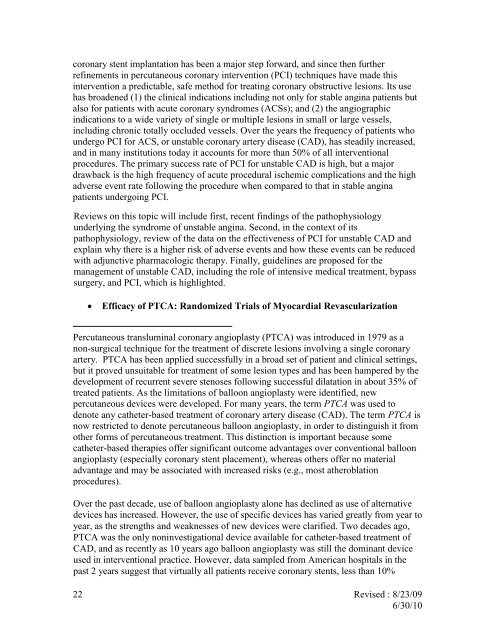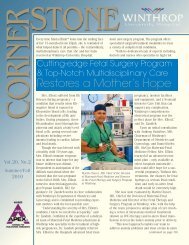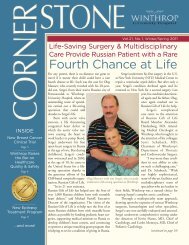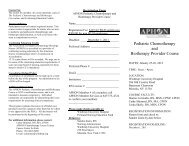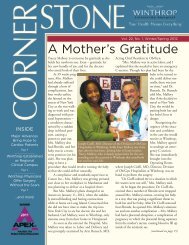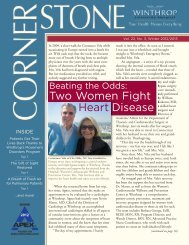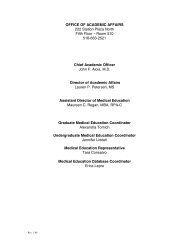interventional cardiology fellowship curriculum - Winthrop University ...
interventional cardiology fellowship curriculum - Winthrop University ...
interventional cardiology fellowship curriculum - Winthrop University ...
You also want an ePaper? Increase the reach of your titles
YUMPU automatically turns print PDFs into web optimized ePapers that Google loves.
coronary stent implantation has been a major step forward, and since then further<br />
refinements in percutaneous coronary intervention (PCI) techniques have made this<br />
intervention a predictable, safe method for treating coronary obstructive lesions. Its use<br />
has broadened (1) the clinical indications including not only for stable angina patients but<br />
also for patients with acute coronary syndromes (ACSs); and (2) the angiographic<br />
indications to a wide variety of single or multiple lesions in small or large vessels,<br />
including chronic totally occluded vessels. Over the years the frequency of patients who<br />
undergo PCI for ACS, or unstable coronary artery disease (CAD), has steadily increased,<br />
and in many institutions today it accounts for more than 50% of all <strong>interventional</strong><br />
procedures. The primary success rate of PCI for unstable CAD is high, but a major<br />
drawback is the high frequency of acute procedural ischemic complications and the high<br />
adverse event rate following the procedure when compared to that in stable angina<br />
patients undergoing PCI.<br />
Reviews on this topic will include first, recent findings of the pathophysiology<br />
underlying the syndrome of unstable angina. Second, in the context of its<br />
pathophysiology, review of the data on the effectiveness of PCI for unstable CAD and<br />
explain why there is a higher risk of adverse events and how these events can be reduced<br />
with adjunctive pharmacologic therapy. Finally, guidelines are proposed for the<br />
management of unstable CAD, including the role of intensive medical treatment, bypass<br />
surgery, and PCI, which is highlighted.<br />
<br />
Efficacy of PTCA: Randomized Trials of Myocardial Revascularization<br />
Percutaneous transluminal coronary angioplasty (PTCA) was introduced in 1979 as a<br />
non-surgical technique for the treatment of discrete lesions involving a single coronary<br />
artery. PTCA has been applied successfully in a broad set of patient and clinical settings,<br />
but it proved unsuitable for treatment of some lesion types and has been hampered by the<br />
development of recurrent severe stenoses following successful dilatation in about 35% of<br />
treated patients. As the limitations of balloon angioplasty were identified, new<br />
percutaneous devices were developed. For many years, the term PTCA was used to<br />
denote any catheter-based treatment of coronary artery disease (CAD). The term PTCA is<br />
now restricted to denote percutaneous balloon angioplasty, in order to distinguish it from<br />
other forms of percutaneous treatment. This distinction is important because some<br />
catheter-based therapies offer significant outcome advantages over conventional balloon<br />
angioplasty (especially coronary stent placement), whereas others offer no material<br />
advantage and may be associated with increased risks (e.g., most atheroblation<br />
procedures).<br />
Over the past decade, use of balloon angioplasty alone has declined as use of alternative<br />
devices has increased. However, the use of specific devices has varied greatly from year to<br />
year, as the strengths and weaknesses of new devices were clarified. Two decades ago,<br />
PTCA was the only noninvestigational device available for catheter-based treatment of<br />
CAD, and as recently as 10 years ago balloon angioplasty was still the dominant device<br />
used in <strong>interventional</strong> practice. However, data sampled from American hospitals in the<br />
past 2 years suggest that virtually all patients receive coronary stents, less than 10%<br />
22 Revised : 8/23/09<br />
6/30/10


